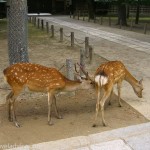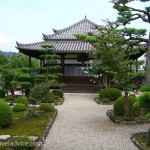
Todaiji Temple in Nara is an awe-inspiring sight and should be at the top of any sightseeing trip to Japan. The temple was built in 752 during the Nara period (710 – 794 AD) at the behest of Emperor Shomu, and is a UNESCO World Heritage Site. The name Todaiji means Great Eastern Temple, and it was built as the head temple of all provincial Buddhist temples in Japan.
Nandaimon – Great Southern Gate
On the way to the temple you will pass through Nandaimon, which is an enormous gate containing two fierce looking Nio Guardians. Nio means Benevolent Kings, and these guardians are protectors against evil spirits. According to Japanese tradition, these guardians travelled with the historical Buddha to protect him.
The wooden guardians were carved by the sculptor Unkei, in the 13th century. They are considered to be some of the finest wooden statues in all of Japan. The statues along with the gate itself are designated national treasures.
You will also be greeted by the deer from nearby Nara Park on your approach to Todaiji. The deer are used to tourist and will often approach you looking for some shika senbei, which are special crackers made for the deer and sold nearby for 150 yen.

Nakamon – Central Gate
The entrance to Todaiji Temple is the Central Gate or Nakamon.

Daibutsuden Hall
Todaiji’s Daibutsuden Hall (Hall of the Great Buddha) is the largest wooden building in the world. It is truly impressive, but consider this. It is only two-thirds the size of the original! The current building dates from 1709 when it was rebuilt. The Daibutsu-den Hall contains The Daibutsu (Great Buddha), which is one of the largest bronze figures in the world. It was originally cast in 746, and the present statue was recast in the Edo period. It stands at just over 16m high and contains 437 tonnes of bronze and 130kg of gold.
As you circle the statue towards the back, you’ll see a wooden column with a hole through its base. The hole is exactly the same size as one of the Great Buddha’s nostrils. Legend says that anyone who can squeeze through the hole will be ensured of enlightenment in their next life.

Todaiji Temple Grounds and Gardens
The grounds at Todaiji Temple are spacious and cover most of the area north of Nara Park. The original complex also contained two 100 meter high pagodas, but these were destroyed by earthquakes.
 Surrounds Near The Main Entrance
Surrounds Near The Main Entrance

History of Todaiji Temple
Todaiji was founded by Emperor Shomu during the Nara period (710 – 794 AD) when Nara was the capital of Japan. The temple complex was fully complete in 798, but the temple had grown so powerful that the Japanese capital was moved from Nara to Nagaoka in 784 in order to reduce its influence on government affairs. The temple remained active over the years, but its wooden buildings have been rebuilt several times over the centuries due to fires and earthquakes. The two 100 meter high pagodas that were part of the original complex, and were probably the highest buildings at the world at the time were destroyed by earthquakes.
Opening Hours
Todaiji is open from
8:00 am to 4:30 pm – November to February
8:00 am to 5:00 pm – March
7:30 am to 5:30 pm – April to September
7:30 am to 5:00 pm – October
Entry Fee
Adults: 500 yen
How to Get There
Todaiji Temple is located in the north of Nara Park. It is around 30 mins on foot from Kintetsu Nara Station, or about a 45 minute walk from JR Nara Station. You can take a bus from either station and get off at the Todaiji Daibutsuden stop. It is around a 5-10 minute walk to the main building from the bus stop.
Address: 406-1 Zoshicho, Nara, Nara Prefecture 630-8211
Best Time to Go
Every season has something to offer, but spring and autumn in Nara are truly beautiful.
Photo Gallery






